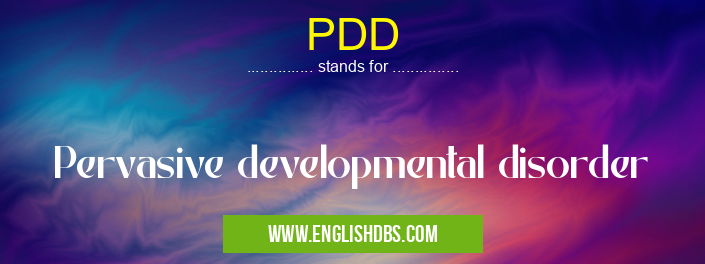What does PDD mean in NEUROLOGY
Pervasive Developmental Disorders (PDD) describes a group of complex neurodevelopmental disorders that are typically diagnosed in early childhood. PDD includes Autism Spectrum Disorder (ASD), Asperger Syndrome, Pervasive Developmental Disorder - Not Otherwise Specified (PDD-NOS), and Childhood Disintegrative Disorder (CDD). These conditions are characterized by impairments in social interaction, communication, and restricted patterns of behavior, interests, or activities. PDDs can range from mild to severe, and the symptoms may vary significantly among individuals with these disorders.

PDD meaning in Neurology in Medical
PDD mostly used in an acronym Neurology in Category Medical that means Pervasive developmental disorder
Shorthand: PDD,
Full Form: Pervasive developmental disorder
For more information of "Pervasive developmental disorder", see the section below.
Symptoms
Individuals who have PDDs often display deficits in communication and language development. They may have difficulty understanding spoken language or expressing their thoughts and feelings through verbal or nonverbal communication. Additionally, people with PDDs often have difficulty understanding facial expressions, body language, and other nonverbal cues that are important components of social interactions. Furthermore, they tend to engage in repetitive behaviors such as hand flapping or rocking back and forth. Individuals with PDDs also tend to be fixated on particular objects or interests.
Diagnosis
Diagnosis of a PDD is based on an evaluation of the individual's behavior and developmental history. A diagnosis is made by an experienced clinician based on the presence of certain characteristic behaviors that are associated with the disorder. Ultimately a diagnosis relies on the judgment of the clinician as there is no single definitive test for diagnosing PDDs.
Treatment
Treatment for people with PDDs varies depending on the severity of their condition and may include medication to reduce problem behavior or relieve any associated anxiety symptoms; behavioral therapies such as applied behavior analysis (ABA); educational support; speech therapy; occupational therapy; physical therapy; psychotherapy; dietary changes; etc. Although there is no known cure for these disorders, early intervention has been found to be beneficial in improving outcomes for children diagnosed with a PDD.
Essential Questions and Answers on Pervasive developmental disorder in "MEDICAL»NEUROLOGY"
What is Pervasive Developmental Disorder (PDD)?
Pervasive Developmental Disorder (PDD) is an umbrella term that includes a broad spectrum of conditions with varying levels of severity. It affects communication, social interactions and behavior and is usually diagnosed in childhood. Common symptoms include difficulty processing social cues, language delays, rigid routines and repetitive behaviors.
What are the different types of PDD?
The five most common types of PDD are Autistic Disorder, Asperger Syndrome, Childhood Disintegrative Disorder, Rett Syndrome and Pervasive Developmental Disorder Not Otherwise Specified (PDD-NOS). These diagnoses can vary depending on the individual’s age and symptom presentation.
How do I know if my child has PDD?
Early diagnosis is key to successful treatment of PDD, so if you have concerns about your child’s development or behavior it’s important to seek professional help. Typically this will involve a combination of psychological assessments and other diagnostic tools to determine if your child meets the criteria for one or more PDD classifications.
How is PDD treated?
Treatment for PDD typically involves an individualized plan that combines behavioral therapy with other therapies such as occupational therapy or speech therapy. In some cases medications can be beneficial in managing associated anxiety or other condition-related symptoms. Treatment plans should always be developed in conjunction with a team of professionals who specialize in working with children with autism spectrum disorders.
Is there a cure for PDD?
While there currently isn’t a “cure” for Pervasive Developmental Disorders, most individuals experience significant improvements due to early intervention and ongoing support services and treatments. The goal is not necessarily to eliminate all symptoms but rather support individuals to manage them so they can achieve their highest level of functioning possible in home, school and community settings.
What therapies might benefit my child with PDD?
A variety of therapies have been found to be effective in helping children on the autism spectrum gain skills needed for success at home school work settings including Applied Behavioral Analysis (ABA), Speech Language Therapy (SLT), Occupational Therapy and Social Skills Training as well as sensory integration interventions such as music therapy or yoga/movement therapy. It may also be beneficial to explore complementary approaches such as Attachment Based Interventions or Parent Training Programs among others.
Are there any organizations that offer support for those with PDD?
Yes, there are numerous organizations dedicated to providing educational resources, family support services and advocacy for those affected by autism spectrum disorder including Autism Speaks and the Autism Society among many others. Many local chapters offer opportunities for families affected by autism within their own communities across the country.
How long will it take before I see results from my child's treatment?
Every person on the autism spectrum is unique so treatment progress will vary significantly from one individual to another depending on severity of symptoms initial starting point etc That said generally speaking families typically begin seeing improvement within 3-6 months after initiating appropriate interventions.
Final Words:
Pervasive Developmental Disorders (PDD) refer to a group of complex neurodevelopmental conditions typically diagnosed in early childhood that are characterized by impairments in communication abilities, social interaction skills, and restricted patterns of behavior interests, or activities. While there is currently no known cure for these disorders treatment plans can vary depending on severity including medication management, behavioral therapies such as ABA , educational support services speech therapy occupational therapy etc . Early intervention has been found to be crucial for improved outcomes when dealing with those affected by one of these conditions .
